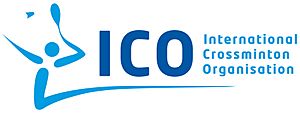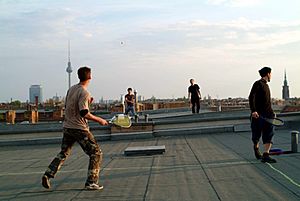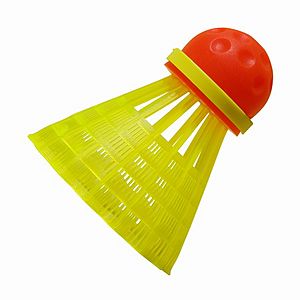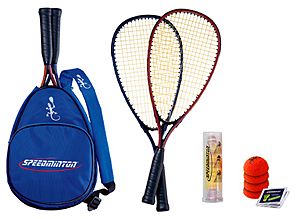Crossminton facts for kids

Logo of ICO
|
|
| Abbreviation | ICO |
|---|---|
| Founded | 25 August 2011 |
| Type | Federation of national associations |
| Legal status | Governing body of crossminton |
| Purpose | Sport governance |
| Headquarters | Berlin, Germany |
|
Region served
|
Worldwide |
|
Membership
|
31 national associations |
|
Official languages
|
English |
|
President
|
Matjaž Šušteršič |
|
Financial officer
|
Yoko Koizumi |
|
Board of Executives
|
Maximilian Franke Petr Marklik Daniel Robles Rodríguez Charly Knobling |
|
Secretary General
|
René Lewicki |
|
Main organ
|
General Assembly |
Crossminton is an exciting racket game that mixes parts of badminton, squash, and tennis. You can play it almost anywhere because it doesn't need a net or a special court. Imagine playing on a tennis court, a street, a beach, a field, or even in a gym!
This sport used to be called Speed Badminton. It was often linked to the brand "Speedminton" because they helped it grow. On January 1, 2016, the name officially changed to Crossminton. Now, people play Crossminton all over the world. More and more clubs are forming, and tournaments are held regularly.
The International Crossminton Organization (ICO) was started in Berlin on August 25, 2011. It was first known as the International Speed Badminton Organisation (ISBO). By 2018, the ICO had 26 member countries from Europe, America, Asia, and Africa.
Contents
How Crossminton Started
The idea for Crossminton and its special shuttlecock came from Bill Brandes in Berlin in 2001. He wanted to create a version of badminton that could be played outdoors. He made the ball, now called a speeder, smaller and heavier. This change helps it fly well even when it's windy.
At first, Bill called his new sport "shuttleball." Soon after, it was renamed "speed badminton." Then, in January 2016, the name changed again to crossminton. Even though it's similar to badminton, Crossminton doesn't use a net and is much faster! By 2003, about 6,000 people in Germany were already playing. The sport continues to grow, with many international tournaments happening across Europe and beyond.
Playing the Game
What You Need to Play
Each player needs a racket. These rackets are similar to squash rackets but are made especially for Crossminton. They are about 58–60 cm long. The materials and strings are different from other rackets.
The ball used in Crossminton is called a speeder. It's heavier than a regular badminton shuttlecock. This design helps it fly straight and fast, even in winds up to force 4 (a moderate breeze).
| Speeder Type | Flight Distance | Speed |
|---|---|---|
| Fun Speeder | 13–18 m | 260 km/h |
| Match Speeder | 17–25 m | 290 km/h |
Setting Up the Court
A Crossminton court has two squares. Each square is 5.5 meters (about 18 feet) long on all sides. The two squares are placed 12.8 meters (about 42 feet) apart from each other.
You can even set up a Crossminton court on half of a tennis court. You just need some elastic lines to mark the squares. For regular games, players use Match Speeders. Younger players (under 12) use Fun Speeders and play on a smaller court (4x4 meters) with the squares only 9 meters apart.
Basic Rules of Crossminton
The main goal of the game is to hit the speeder so it lands inside your opponent's square. If the speeder lands outside their square, you get a point! Players can move anywhere inside or even outside their own square during the game.
A game ends when one player reaches at least 16 points. They also need to have at least a 2-point lead over their opponent. After each game (or "set"), players switch sides of the court. This helps make sure conditions like wind or sunlight are fair for everyone.
How to Win a Match
A match usually means winning two out of three games (sets). So, the first player to win two sets wins the whole match. If the score in a set is tied at 15-15 or higher, play continues until one player has a 2-point lead.
Serving the Speeder
To decide who serves first, players can flip a coin or throw a speeder. Each player gets three serves in a row. Every time the speeder is hit back and forth (a "rally"), a point is scored. If the score reaches 15-15, the serve changes after every point.
You must serve from a special area, which is 3 meters behind the front line of your square. You can't step over this line when you serve. The serve must be hit from below, in an upward motion. The player who lost the previous set gets to serve first in the next set.
Scoring Points
You score a point in Crossminton if:
- The serve isn't done correctly.
- The speeder hits the floor or the roof.
- The speeder lands in your opponent's square and they can't hit it back.
- The speeder lands outside the court (the lines are considered part of the court).
- A player touches the speeder twice in a row.
- The speeder touches a player's body.
If a player hits the speeder back from outside the court, the game continues.
Changing Sides
Players switch sides after each set. This makes sure that things like wind or bright lights don't give one player an unfair advantage. If a third game (called a tiebreak) is needed, players switch sides after every 6 points.
Different Ways to Play
- Doubles: In doubles, two players team up on one court. The serving team decides who serves first. The server stands at the back line, and their partner stands in front. Serves rotate among all four players. The team that lost the previous set serves first in the next one.
- Blackminton (Playing in the Dark): Crossminton can be played at night using special glowing equipment and black lights! This version is called Blackminton. You can use fluorescent paint for the court lines, glowing rackets, and special "night speeders" with glow sticks inside them. This makes playing in the dark super cool!
Big Tournaments: World & European Championships
The very first Crossminton World Championships (then called Speed Badminton) happened on August 26-27, 2011. Over 380 players from 29 countries came to Berlin to compete! Players from Canada, the US, and Australia even joined in.
Since then, the World and European Championships take turns happening every year. These big events bring together the best Crossminton players from around the globe!
| Year | Tournament | City | Open Division | Female Open | Open Doubles | Female Doubles | Mixed Doubles | U18 (U19 since 2021) Male | U18 (U19 since 2021) Female | |||||||
|---|---|---|---|---|---|---|---|---|---|---|---|---|---|---|---|---|
| Champion | Runner-up | Champion | Runner-up | Champion | Runner-up | Champion | Runner-up | Champion | Runner-up | Champion | Runner-up | Champion | Runner-up | |||
| 2011 | 1. ICO Crossminton World Championships | not played | not played | |||||||||||||
| 2012 | 3. ISBO European Championships | |||||||||||||||
| 2013 | 2. ICO Crossminton World Championships | |||||||||||||||
| 2014 | 4. ISBO European Championships | |||||||||||||||
| 2015 | 3. ICO Crossminton World Championships | |||||||||||||||
| 2016 | 5. ICO European Championships | |||||||||||||||
| 2017 | 4. ICO Crossminton World Championships | |||||||||||||||
| 2018 | 6. ICO Speedminton European Championships 2018 | |||||||||||||||
| 2019 | 5. ICO Crossminton World Championships | |||||||||||||||
| 2020 | 6. ICO European Championships 2020 (Cancelled : Covid-19 pandemics) | |||||||||||||||
| 2021 | 6. ICO Crossminton World Championships (played in 2022 due to Covid-19 pandemics) | |||||||||||||||
International Tournaments
The International Crossminton Organization (ICO) supervises many international tournaments around the world. Each member country can host certain types of tournaments each year. There are only five "1000 points" tournaments each year. The ICO chooses these based on applications from member countries. The series of "1000 points" and "500 points" tournaments is called the World Series.
When players join international ICO tournaments, they earn ranking points based on how well they do. These points help decide their "seeding" (their rank) for future tournaments.
| Date | Tournament | City | Open Division | Female Open | Open Doubles | |||
|---|---|---|---|---|---|---|---|---|
| Champion | Runner-up | Champion | Runner-up | Champion | Runner-up | |||
| 17.-18.3.2018 | 10. ICO Speedminton® Slovenian Open | |||||||
| 28.-29.4.2018 | 10. ICO Speedminton® Hungarian Open | |||||||
| 5.-6.5.2018 | 11. ICO Speedminton® Croatian Open | |||||||
| 19.-20.5.2018 | 9. ICO Speedminton® SLOVAK Open | |||||||
| 1.-2.6.2018 | ICO Speedminton® Japan Open | |||||||
| 22.-23.6.2018 | ICO Speedminton® Polish Open | |||||||
| 21.7.2018 | 2018 ICO Speedminton® Swedish Open | |||||||
| 8.-9.9.2018 | 2018 ICO Speedminton® Serbian Open | (future event) | ||||||
| 29.-30.9.2018 | 8. ICO Speedminton® Czech Open 2018 | (future event) | ||||||
| 19.-21.10.2018 | 2018 ICO Speedminton® German Open | (future event) | ||||||
| 9.-10.11.2018 | 2018 ICO Speedminton® Latvian Open | (future event) | ||||||
| 17.-18.11.2018 | 2018 ICO Speedminton® Spanish Open | (future event) | ||||||
* 1000 points tournaments are denoted in bold characters
Nations Cup: Team Competition
Since 2013, the ICO has also held a team competition called the ICO Nations Cup. It's like the Davis Cup or Fed Cup in tennis, but in Crossminton, teams are mixed with both male and female players.
First, teams play in regional tournaments. The winners of these regional events, called "Regional Champions," then compete for the title of ICO Nations Cup Champion at a final tournament.
A national team needs at least three players: usually two male players and one female player. They can have up to five players in total, with two reserves who can play in singles or doubles matches. When two national teams play against each other, they have 6 matches: 4 singles matches and 2 doubles matches.
| Year | Final Tournament Venue | Champion | Runner-up |
|---|---|---|---|
| 2013 | |||
| 2014 | |||
| 2015 | |||
| 2016 | |||
| 2017 | |||
| 2018 | |||
| 2019 | |||
| 2020 | (not played) | (not played) | |
| 2021 | (not played) | (not played) | |
See also
 In Spanish: Speed badminton para niños
In Spanish: Speed badminton para niños




